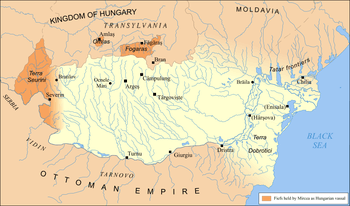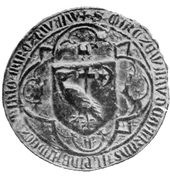Mircea I of Wallachia
Mircea the Elder (Romanian: Mircea cel Bătrân, pronounced [ˈmirt͡ʃe̯a t͡ʃel bəˈtrɨn] (![]()
| Mircea the Elder | |
|---|---|
| Voivode of Wallachia | |
 Mircea the Elder. Fresco in the Episcopal Church of Curtea de Argeș | |
| Voivode of Wallachia (1st reign) | |
| Reign | 23 September 1386 – November 1394 |
| Predecessor | Dan I of Wallachia |
| Successor | Vlad I of Wallachia |
| Voivode of Wallachia (2nd reign) | |
| Reign | January 1397 – 31 January 1418 |
| Predecessor | Vlad I of Wallachia |
| Successor | Michael I of Wallachia |
| Born | c.1355 |
| Died | 31 January 1418 (aged 62–63) |
| Burial | 4 February 1418 |
| Spouse | Doamna Mara Doamna Anca |
| Issue | Michael I of Wallachia Radu II Praznaglava Alexandru I Aldea Vlad II Dracul Ana of Wallachia Arina of Wallachia |
| House | Basarab |
| Father | Radu I of Wallachia |
| Mother | Doamna Calinichia |
| Religion | Orthodox Christian[1] |
Family
Mircea was the son of voivode Radu I of Wallachia and his wife, Doamna Calinichia,[4] thus being a descendant of the House of Basarab.[5] He was the father of Vlad II Dracul and Alexander I Aldea, and grandfather of Mircea II, Vlad Țepeș (Dracula), Vlad Călugărul and Radu cel Frumos. All of these would at one time or the other rule Wallachia, with Mircea II and Vlad Țepeș both being able military commanders (the latter became one of the most notorious leaders in history, and is commonly believed to be the inspiration for the novel Dracula by Bram Stoker).
Reign

Mircea's reign is often considered to have brought stability to Wallachia. Found in a volatile region of the world, this principality's borders constantly shifted, but during Mircea's rule, Wallachia controlled the largest area in its history: from the Southern Carpathians in the north to the Danube in the south, and from today's Iron Gates on the Danube in the west to the Black Sea in the east.[6]
Mircea strengthened the power of the state and organized the different high offices, promoted economic development, increased the state's revenue, and minted silver money that enjoyed wide circulation not only inside the country but also in neighboring countries. He gave the merchants of Poland and Lithuania trade privileges and renewed those his predecessors had given to the people of Braşov. As a result, Mircea was able to afford increasing his military power. He fortified the Danube citadels and strengthened "the great army" made up of townspeople and of free and dependent peasants. He also proved to be a great supporter for the Eastern Orthodox Church.[7] Mircea the Elder is the first in the region to deal with slaves giving 300 gypsy dwellings to a monastery in 1388.[8]
While organizing the country and its institutions, Mircea also formed a system of lasting alliances which enabled him to defend the independence of the country. Through the intermediary of Petru Muşat, the prince of Moldavia, he concluded a treaty of alliance with Władysław II Jagiełło, king of Poland in 1389.[9] The treaty was renewed in 1404 and 1410.[10] He maintained close relations with Sigismund of Luxembourg, the king of Hungary, relying on their common interest in the struggle against Ottoman expansion.[11][12]
Conflicts with the Ottoman Empire

His interventions in support of the Bulgarians south of the Danube who were fighting against the Turks brought him into conflict with the Ottoman Empire. In 1394, Beyazid I (also known as "Yıldırım Beyazıt", "the Thunderbolt") crossed the Danube river, leading 40,000 men, an impressive force at the time. Mircea had only about 10,000 men so he could not survive an open fight. He chose to fight what would now be called a guerrilla war, by starving the opposing army and using small, localized attacks and retreats (a typical form of asymmetric warfare). On October 10, 1394, the two armies finally clashed at the Battle of Rovine, which featured a forested and swampy terrain, thus preventing the Ottomans from properly spreading their army; Mircea finally won the fierce battle and threw the Ottomans out of the country.[13][14] This famous battle was later epically described by the poet Mihai Eminescu in his Third Epistle. However, Mircea had to retreat to Hungary, while the Turks installed Vlad Uzurpatorul on the throne of Wallachia.[15]
In 1396, Mircea participated in an anti-Ottoman crusade started by Hungary's monarch. The crusade ended with the Ottoman victory at the Battle of Nicopolis on September 25.[13] In the next year, 1397, Mircea, having defeated Vlad the Usurper with Hungarian help, stopped another Ottoman expedition that crossed the Danube, and in 1400 he defeated yet another expedition of Turks crossing the country.[16]
The defeat of Sultan Beyazid I by Timur Lenk (Tamerlane) at Ankara in the summer of 1402 opened a period of anarchy in the Ottoman Empire and Mircea took advantage of it to organize together with the Hungarian king a campaign against the Turks. In 1404 Mircea was thus able to impose his rule on Dobruja again. Moreover, Mircea took part in the struggles for the throne of the Ottoman Empire and enabled Musa to ascend that throne (for a brief reign). It was at this time that the prince reached the height of his power.[17]
Towards the end of his reign, Mircea signed a treaty with the Ottomans; in return for a tribute of 3,000 gold pieces per year, the Ottomans desisted from making Wallachia a province ("pashalik").[18]
Legacy
The "bravest and ablest of the Christian princes", as he was described by German historian Leunclavius, ruled Wallachia for 32 years.[19] Mircea was a ktetor, building among other monuments, the Cozia Monastery near Călimănești in ca. 1390. He had churches built after Serbian architectural styles, after the models of the Lazarica Church, Veluće, Naupara, and Kalenić monastery.[20]

Грамота отъ Мирчо войвода, издадена въ Гюргево въ 6917 (1409.) год.
Грамоти отъ Влахия: http://macedonia.kroraina.com/lm_da/lm_da_dako-romyni_3a.htm#4
In popular culture
Mircea was played by Sergiu Nicolaescu in the 1989 film Mircea, which was also directed by Nicolaescu.[21]
See also
| Ancestors of Mircea I of Wallachia | |||||||||||||||||||||||||||||||||||||||||||||||||||||||||||||||||||||||||||||||||||||||||||||||||||||||||||||||||||||||||||||||||||||||||||||||||||||||||||||||||||||||||||||||||||||||||||||||||||||||||||||||||||||||||||||||||||||||||||||||||||||||||||||||||||||||||||||||||||||||||||||||||||||||||||||||||||||||||||||||||||||||||||||||||||||||||||||||||||||||||||||||||||||||||||||||||||||||||||||||||||||||||||||||||||||||||||||||||||||||||||||||||||||||||||||||||||
|---|---|---|---|---|---|---|---|---|---|---|---|---|---|---|---|---|---|---|---|---|---|---|---|---|---|---|---|---|---|---|---|---|---|---|---|---|---|---|---|---|---|---|---|---|---|---|---|---|---|---|---|---|---|---|---|---|---|---|---|---|---|---|---|---|---|---|---|---|---|---|---|---|---|---|---|---|---|---|---|---|---|---|---|---|---|---|---|---|---|---|---|---|---|---|---|---|---|---|---|---|---|---|---|---|---|---|---|---|---|---|---|---|---|---|---|---|---|---|---|---|---|---|---|---|---|---|---|---|---|---|---|---|---|---|---|---|---|---|---|---|---|---|---|---|---|---|---|---|---|---|---|---|---|---|---|---|---|---|---|---|---|---|---|---|---|---|---|---|---|---|---|---|---|---|---|---|---|---|---|---|---|---|---|---|---|---|---|---|---|---|---|---|---|---|---|---|---|---|---|---|---|---|---|---|---|---|---|---|---|---|---|---|---|---|---|---|---|---|---|---|---|---|---|---|---|---|---|---|---|---|---|---|---|---|---|---|---|---|---|---|---|---|---|---|---|---|---|---|---|---|---|---|---|---|---|---|---|---|---|---|---|---|---|---|---|---|---|---|---|---|---|---|---|---|---|---|---|---|---|---|---|---|---|---|---|---|---|---|---|---|---|---|---|---|---|---|---|---|---|---|---|---|---|---|---|---|---|---|---|---|---|---|---|---|---|---|---|---|---|---|---|---|---|---|---|---|---|---|---|---|---|---|---|---|---|---|---|---|---|---|---|---|---|---|---|---|---|---|---|---|---|---|---|---|---|---|---|---|---|---|---|---|---|---|---|---|---|---|---|---|---|---|---|---|---|---|---|---|---|---|---|---|---|---|---|---|---|---|---|---|---|---|---|---|---|---|---|---|---|---|---|---|---|---|---|---|---|---|---|---|---|---|---|---|---|---|---|---|---|---|---|---|---|---|---|---|---|---|---|---|---|---|---|---|---|---|---|---|---|---|---|---|---|---|---|---|---|---|---|---|---|---|---|---|---|---|---|---|---|---|---|---|---|---|---|---|---|
| |||||||||||||||||||||||||||||||||||||||||||||||||||||||||||||||||||||||||||||||||||||||||||||||||||||||||||||||||||||||||||||||||||||||||||||||||||||||||||||||||||||||||||||||||||||||||||||||||||||||||||||||||||||||||||||||||||||||||||||||||||||||||||||||||||||||||||||||||||||||||||||||||||||||||||||||||||||||||||||||||||||||||||||||||||||||||||||||||||||||||||||||||||||||||||||||||||||||||||||||||||||||||||||||||||||||||||||||||||||||||||||||||||||||||||||||||||
Mircea I of Wallachia Born: 1355 Died: 1418 | ||
| Regnal titles | ||
|---|---|---|
| Preceded by Dan I |
Voivode of Wallachia 1386–1394/1395 |
Succeeded by Vlad I Uzurpatorul (The Usurper) |
| Preceded by Vlad I Uzurpatorul |
restored as Voivode of Wallachia 1397–1418 |
Succeeded by Mihail I |
Notes
- "Mircea cel Bătrân". Enciclopedia României (in Romanian).
- Dr. Brackob, A.K. (2018). Mircea the Old: Father of Wallachia, Grandfather of Dracula. Buffalo, U.S.A.: Center for Romanian Studies / Histria Books. pp. 9–11. ISBN 9781592110018.
- Hasdeu, p. 130; Xenopol, p, 89; Iorga, p. III
- Panaitescu, P. P. "II. Mircea cel Bătrân. Originea și familia lui". Mircea cel Bătrân (PDF) (in Romanian) (II ed.). Corint.
- Giurescu, pp.362
- Giurescu, pp.363
- . SEVEREANU, Ducaţii Ţării Române şi cu numele a doi domnitori: Vlad I şi Mircea I, Bucureştii, l, 1935, p. 250-260
- Achim, Viorel (2004). The Roma in Romanian History. Central European University Press. p. 14. ISBN 963-9241-84-9.
- M. Manea, A. Pascu, B. Teodorescu, Istoria Românilor din cele mai vechi timpuri până la revoluția din 1821, Ed. Didactică și Pedagogică, București, 1997, p. 231.
- Constantin C. Giurescu, Dinu C. Giurescu, Istoria românilor. Vol. 2, Ed. Ştiinţifică şi Enciclopedică, Bucureşti,1976. p. 83
- „Marele Mircea voievod", Bucureşti, 1987
- 1388 - 1390: Kaplai Ianos; 1390 - 1391: Mihai Perényi; 1392: Gerbeni Szemere; 1392 - 1393: Ditrich Bebek.
- Stoica, Vasile (1919). The Roumanian Question: The Roumanians and their Lands. Pittsburgh: Pittsburgh Printing Company. p. 16.
- Giurescu, pp. 367
- P. P. Panaitescu, Mircea cel Bătrân. Ed. Corint, Bucureşti,2000, p.303
- Giurescu, pp. 368.
- Giurescu, pp. 369
- Giurescu, p. 370.
- C-tin C. Giurescu, p. 384
- Ion Pătroiu (1987). Marele Mircea Voievod. Editura Academiei Repubvlicii Socialiste România. p. 460.
- https://www.imdb.com/title/tt0126439/
References
| Wikimedia Commons has media related to Mircea I of Wallachia. |
- (in Romanian) Bogdan Petriceicu Hasdeu, Istoria critică a românilor, vol. I, Bucharest, 1875
- (in Romanian) A. D. Xenopol, Istoria românilor din Dacia Traiană, vol. I, Iaşi, 1889
- (in Romanian) Nicolae Iorga, Studii şi documente cu privire la istoria românilor, vol. III, Bucharest, 1901
- (in Romanian) Constantin C. Giurescu, Istoria Românilor, vol. I, Bucharest, 1938
- (in English) Dr. A.K. Brackob, Mircea the Old: Father of Wallachia, Grandfather of Dracula, Buffalo U.S.A., 2018